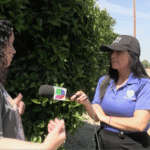

As an investigator for CAPS, I’ve been inside 700 puppy mills. After that many rusty cages, crowded pens, and terrified barking dogs, you’d think it would all run together — one big pet-producing factory in my mind. But despite the identical conditions I’ve seen across the country, there are still some places you never forget. No matter how hard you try…
Dennis and Donna Van Wyk run a USDA-licensed dog breeding facility in Iowa, where they produce puppies for the pet shop industry. CAPS has been monitoring it for a decade and a half, documenting horrible animal welfare violations there. I recently went in, hoping to find improvements since my last visit. But sadly, nothing had changed.

I saw forty-five dogs and four puppies on the property, but I could hear more just out of view. Paint peeled from the wooden and wire cages. Feces covered the floors. There were dogs with missing eyes. Dogs with injured feet. And a German Shepherd with a bloody swollen ear, limply hanging, and a gash across her bleeding nose.
All of these conditions are violations of the Animal Welfare Act.
There was one puppy at the facility — a seven-month-old Schnauzer mix — that Mr. Van Wyk took from a cage to show me. The puppy was soaked and smelled like ammonia, urine, and feces. He hugged the grass when he walked, as if not used to firm ground, and scampered like a wild animal. No matter what I tried, I couldn’t get him to play with me. I think playtime was just something he knew nothing about.

After my investigation, CAPS worked with the Animal Rescue League of Iowa to get our evidence to the local sheriff’s department. A deputy was sent out, but she claimed not to see anything unsanitary or any unhealthy dogs. Given what I had just witnessed, I find that extremely hard to believe and very suspicious.
The real tragedy is that Van Wyk’s facility looks just like it did in 1999, when CAPS first went there. Since then we’ve documented countless violations like sick dogs, contaminated water, overcrowded cages, and feces falling from elevated cages onto dogs trapped below. We’ve seen cages so overflowing with feces that the dogs inside couldn’t lie down without mashing it into their fur. Dateline NBC even partnered with us to feature Van Wyk in a special about puppy mills; the place is that bad.

So why hasn’t the USDA terminated Van Wyk’s license?
And what can you do to help?
Please write to USDA Deputy Administrator Bernadette Juarez to ask why the Van Wyks still have a USDA license after so many years of serious violations, and demand that they be investigated. Immediately.
Ms. Bernadette Juarez
Deputy Administrator
USDA/APHIS/AC
4700 River Road, Unit 84
Riverdale, MD 20737
Bernadette.r.juarez@aphis.usda.gov
Your pressure will help bring about the legal action needed to protect these dogs and help other animals suffering around the country.

Thankfully, I was later able to return to the Van Wyk facility and rescue the seven-month-old Schnauzer mix. I named him Teddy and, after a bath, we shared a sleepless night. Teddy cowered for hours before letting me pet him. Then he clung to my side, showing no typical dog behavior like barking, licking, or wagging his tail.
Teddy is now in a happy new home, but his parents are still trapped in the cages at Van Wyk’s. Please share this story, and consider making a donation to CAPS to help us continue these investigations. Together, with your help, we can bring an end to the suffering of animals in the pet shop and puppy/kitten mill industries.




